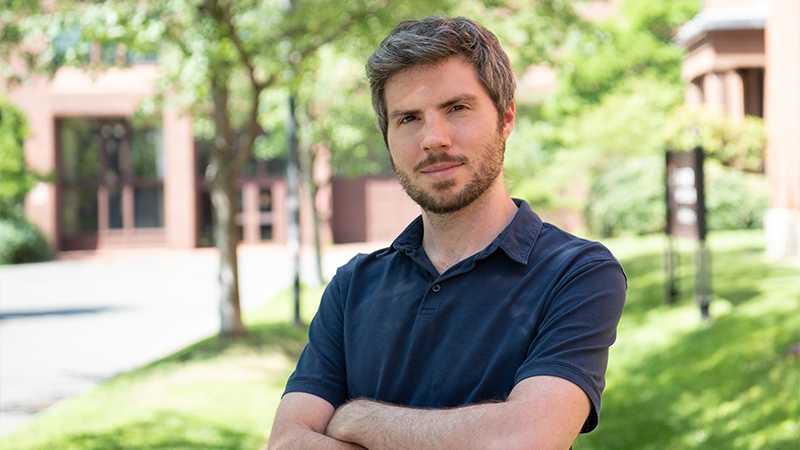Smoke, fresh-baked pie, rotten food, a floral cologne — at least once in your life (probably more), you’ve smelled one of these and tried to figure out where it came from. In each case, you can imagine an odor trace that travels through space and time until it reaches your nose, and your olfactory system detects it. But in natural environments, wind and other factors break up these odor traces (or “plumes,” as we call them) into signals that are sparse and highly fluctuating — nothing like the steady, delicious gradient of pie smell when you walk into a bakery. My work aims to understand how animals integrate this noisy odor information over time to figure out where an odor is coming from — and more specifically, which brain areas are involved, and how neurons in those areas weigh odor information to make these estimations.
Photo by Celia Muto
What are the big questions driving your research?
I am very interested in how sensory inputs are transformed into neural representations that other brain areas can interpret to guide behavioral decisions. This transformation is shaped not only by the properties of the inputs, but also by the anatomy of the system and the special features of the synapses along the pathway. At each step, sensory information may be relayed unchanged, but each step also offers an opportunity for modifications in encoding—potentially leading to information loss, compensation, or accumulation over time. Eventually, sensory information may be sufficient for the animal to make a decision: keep moving in this direction, do not eat that, and so on.
One of the main questions driving my research is how different brain areas contribute to transforming sensory information into decisions (currently, in the context of odor-guided navigation) and how the physiological properties of neurons in different parts of the pathway support that process. In the future, I aim to examine this transformation in the broader context of other brain processes occurring simultaneously. For example, some decisions require animals to learn specific associations between stimuli and outcomes, raising the question of whether and how learning reshapes the circuits that convert sensory information into decisions. Additionally, decisions are not determined solely by precise information processing—they can also be influenced by biases and by changes in the motivation to pursue certain outcomes.
What drew you to this area of neuroscience?
Since switching my interests toward neuroscience in my undergraduate years, the neurobiology of sensory systems has been my focus. At first—likely influenced by my stronger background in cellular and molecular biology than in neuroscience—I was fascinated by the cellular mechanisms through which sensory receptor cells transform stimuli from the external world into signals the brain can interpret. I was also interested in how environmental hazards can affect sensory physiology, so it was a perfect fit to begin studying the effects of noise exposure on hair cells.
By the time I began looking for postdoctoral positions, I had become more drawn to the question of how neural circuits integrate sensory inputs to guide animal behavior. If someone had told me 10 years ago that I would be working on the olfactory system, I probably wouldn’t have believed it. But then I found Venki’s lab, and the opportunity to work on a project about the temporal integration of odor signals came up. It was exactly what I was looking for. Soon after, I became not only fascinated by the olfactory system but also aware of how many challenging questions remain open. I am truly grateful for this opportunity, as it has allowed me to view sensory information processing from a broader perspective—one that also considers phenomena such as decision-making and learning.
What is the trait you most admire in others?
Humility — especially now, when haughtiness and arrogance often go unchallenged (or even seem valued) in public discourse. Sometimes our hypotheses, the rationale for our experiments, or even our interpretation of results can be wrong, and while everyone would prefer to notice flaws themselves, science is a collective enterprise: we must be prepared to take criticism from anyone and acknowledge others’ contributions. Humility is also essential for appreciating the logical and creative processes of others and using them as inspiration for new ideas — otherwise, you risk staying stuck in your own mind.
What is an emerging area of science that you are excited about? Where do you see potential for big discoveries in the next decade?
While I believe any neuroscience research project has value if it helps us better understand how the brain works, I find the potential application of new discoveries to improve brain–computer interfaces particularly exciting. This is an area of research with immediate applications that could significantly enhance the quality of life for people with disabilities or mental health challenges.
At the same time, I think it’s important to keep one foot in the natural world and devote part of our focus to studying how the brains of certain animals solve highly specific tasks in their environments, whether innately or through learning. In doing so, we not only uncover alternative ways evolution may have shaped neural circuit function, but we can also find inspiration for designing devices modeled on the architecture of these natural circuits.
What are your hobbies outside of the lab—current, past, or future?
It’s becoming hard for me to find time for hobbies, but when I do, I like activities that let my brain rest for a while—especially cooking (mostly baking and making ice cream), gardening, and taking day-long bike trips around Massachusetts with my partner. In the past, I really enjoyed writing short fiction, and I hope to find time to return to that soon.

